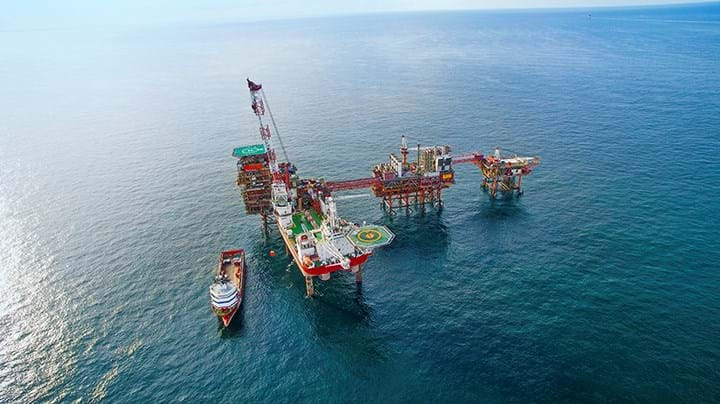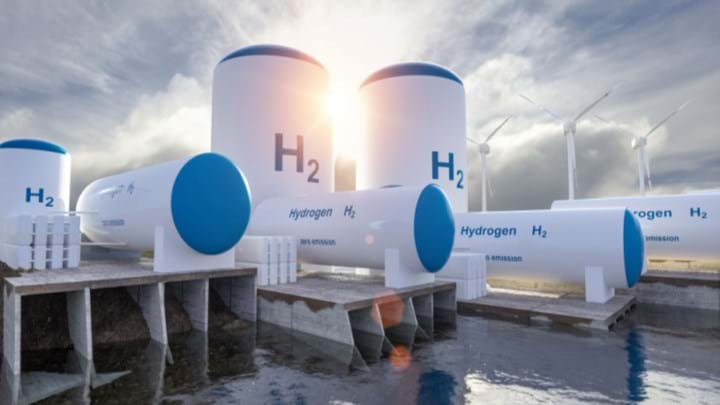Step on the Gas (Storage)

David Simmonds asks how do we achieve energy security and what’s the role of gas storage?
WITH concerns raised about the how resilient our energy storage systems are in the midst of our ongoing energy transition – and the threats to the security of our gas and energy supplies following the war in Ukraine – what does it all mean for our energy security?
A recent report from the LCP consultancy highlighted the risk of renewables having an oversupply of capacity at times of excess wind or solar. The availability of renewables also leads to the flipside of undersupply during periods of low natural resource. With the challenges anticipated this winter, the UK Government has, to the dismay of many environmentalists, rightly delayed the decommissioning of EDF’s coal-fired power stations and it is also in discussion with Drax and Uniper on similar measures. Where does this take us short term and longer term? As we will see the answer lies with a range of energy storage solutions.
First though I would like to define "energy security", which put simply is “to maintain power and energy supplies to all consumers during periods of peak demand and/or drops in supply”. In other words to avoid blackouts which can cause widespread disruption such as what happened in February 2021 in Texas. We need this while we simultaneously see an increased dependency on power for all our major services including the internet, transport, schools and hospitals. However, this is not a new challenge, but one we have to again address for today and tomorrow.
How did we provide energy security in the past?
Power (electricity), with less seasonal swing, was typically generated from gas and nuclear with surplus generation capacity provided by coal-fuelled power stations with stored banks of coal. On the other hand, gas for heating, with greater seasonal swing, has been underpinned through excess production capacity, gasometers, pipeline buffer, salt caverns and other underground gas storage. More recently, storage has been replaced by LNG import flexibility. Transport fuels, which see less seasonal swing, have been managed separately outside the power/gas energy envelope and typically are managed through tanker bunkering.
Price has always been a big factor in our energy market, with gas energy prices typically one quarter that of electricity prices (per KWh) and this difference will likely remain a key driver for energy usage over the coming years. Both gas and power have typically been charged on an annual tariff basis, with suppliers managing measures to provide capacity to meet peak demands through standing charges. Countries more dependent upon higher-cost power supplies for heating, such as in Scandinavia, have seen greater penetration of building efficiency measures and heat pumps. Transport fuel prices at the pump have seen more volatility over the years as, after tax, these are directly related to the international oil price.
With its greater seasonal swing, natural gas provides the greater challenge for energy providers. Personally, when working for NAM in the Netherlands in the 1990s, I studied those peak winter gas demands when I led the team looking at measures to extend the life of the Groningen gas field, which had a peak shaving role for the whole of NW Europe from as far back as the 1960s. As well as improving the send-out capacity of the field with new compression, we designed two major underground gas storage reservoirs, Norg and Grijpskerk, to accept summer gas which could be back-flowed at very high rates on cold winter days. We designed these facilities to meet worst scenario, 1-in-100 year winter, demand rates. Buyers of gas did not see the direct cost of these measures as costs were built into average sales prices. Possibly the 1-in-100 year criteria is too expensive a target today, but we still need to have a standard and contingency plans for possible failure of the system.
In the 2000s, working for what was the BG Group, I helped implement its natural gas strategy, which included the commoditisation of LNG, allowing it to become fully tradeable internationally, capable of meeting peak gas demands in a range of countries. As these demands don’t normally coincide, the global market for LNG has been balanced over the year, allowing supplies to open up to new markets, and reduce seasonal gas price spreads in established markets. In turn this has reduced the business case for operating gas storage, and facilities such as Grijpskerk have been much underutilised, while in the UK, Centrica’s Rough has been decommissioned. That said, today’s gas storage capacity in the EU is still reported to be in the order of 1,100 TWh.
The impact of Ukraine?
The war in Ukraine has led many countries to reduce their take of Russian pipeline gas and supplies of Arctic LNG. Fortunately this has occurred in the European spring, when demand for gas seasonally reduces and LNG supplies from other areas have been able to fill much of the gap.
Nonetheless the supply market is still finite and is further constrained by the limited number of LNG import terminals on mainland Europe. The UK has been able to import more gas through its LNG terminals and pass on supplies to mainland Europe via its interconnectors. However, importers overestimated this capacity and we have seen wholesale prices for gas drop in the UK as a result of over importation and lack of interconnector capacity. As the pundits have stated, if available, Rough could have been refilled comparatively cheaply, and indeed, in what is the first stage of a reopening bid, the North Sea Transition Authority (NTSA) has granted a licence to Centrica.
While we have already seen gas prices rise as a result of higher demand for more expensive LNG supplies, if the embargo on Russian gas continues, we can anticipate further price hikes over the coming winter. As more LNG supplies are taken up as baseload, the ability of LNG markets to meet peak winter demand rates will be significantly impacted. As a result the call for the re-instatement of natural gas storage capacity is being made loud and clear! Indeed the EU has recently set out new guidelines to ensure, where possible, existing storage is appropriately replenished over the summer.

The impact of increasing power demand and penetration of renewables?
As the share of renewables in our overall power portfolio increases, we are starting to see significant supply-side swings. Demand-side swings on power will also become more apparent with the takeup of heat pumps and direct electric heating replacing gas boilers and heaters. Supply- and demand-side swings are unlikely to coincide and, in particular, drops in solar array supplies run counter to peak winter demands.
Ultimately, supply- and demand-side swings will be managed through pricing, with consumers widely utilising smart meters to measure demand over 30-minute time windows. Prices will drop during periods of oversupply and increase significantly when balancing is a challenge. Management of the supply/demand balance across our grids is going to be an order of magnitude more complex than in it was in the past, and the UK Government’s initiative to establish a Future System Operator as part of its Energy Security Strategy is to be welcomed, though it will need appropriate powers and targets (remember that 1-in-100 year target?). The wider impact of demand pricing will also have to be established, particularly on those who are already ‘fuel impoverished’.
Price arbitrage resulting from such measures will drive the market for long-term energy storage. The Long Duration Energy Storage (LDES) study by McKinsey only covers power storage as, at this stage, its work does not consider hydrogen options. Looking at that study McKinsey estimates that, worldwide, LDES could provide up to 140 TWh capacity by 2040 at a cost of up to US$3 trn! As we can see, this is still only a fraction of the current EU gas storage energy capacity noted above. Of course we are not talking like-for-like here as power storage has more value than gas storage, KWh for KWh, but if a significant proportion of that power is primarily being used to replace natural gas, then the comparison becomes more meaningful. We can foresee the need for a wide mix of high to low grade and short to long term energy storage to meet our future power needs.

A role for hydrogen and ammonia in energy security?
Price arbitrage from renewable energy will facilitate the opportunity for conversion of "excess" energy to produce green hydrogen via electrolysis. Of course this comes with efficiency losses, so wherever possible renewable energy should be utilised directly. However as excess capacity, as foreseen by the aforementioned LCP study, grows, unutilised grid-based power should be converted to hydrogen and/or ammonia for use as an alternative fuel. Even more feasible is the production of dedicated (off-grid) low-cost green hydrogen and/or ammonia in locations such as Australia, North Africa or the Middle East which benefit from low cost renewable energy potential – an example is the Asian Energy Renewable Hub (AERH) in Australia. We can envisage development of international markets for both hydrogen and ammonia much like today’s LNG, which, as we have seen, underpins today’s energy security. Of course the scale of their deployment will depend upon a number of technical and safety challenges; these have been well covered in recent issues of TCE and are a key remit for today’s chemical engineering community.
DNV’s recent hydrogen Forecast to 2050 attempts to quantify the potential for hydrogen and ammonia in our future energy mix and I won’t repeat its conclusions here, other than to say that it anticipates green hydrogen/ammonia playing a key role for decarbonising industry and heavy transport. To get to that point it also sees blue hydrogen playing a role to facilitate a rapid scaleup of hydrogen/ammonia technologies and infrastructure. Personally I also see opportunity for wider deployment of hydrogen for domestic heating due to the challenges and cost of deploying heat pumps in older properties, particularly in the UK where we have almost the highest usage rate of natural gas for building heating globally. Unless power prices drop relative to their 3 to 4 premium over natural gas, blue hydrogen produced from natural gas will still be cheaper per KWh than power. DNV’s 2020 blue hydrogen at US$3/kg has an energy equivalent cost of only US$0.1/KWh, which compares favourably to today’s escalating cost of power!

Given the challenges to scale up power storage, concerted efforts are required to develop large-scale storage of hydrogen and/or ammonia which can be used to ensure future energy security. Utilising salt caverns and/or disused natural gas reservoirs for hydrogen provides a real opportunity for that long-term security. The French gas energy company, Teréga, is already looking at storage of hydrogen in salt caverns, while in the UK the North Sea Transition Authority is proceeding with a programme to convert disused gas reservoirs for carbon dioxide sequestration. The next step in its programme must be to look at these for hydrogen storage. While the alternative could be to rely on hydrogen or ammonia imports, recent experience with the LNG market highlights the risk of not having domestic storage. Of course storage incurs contamination and will degrade quality, so we would have to repurify the hydrogen for certain uses such as in fuel cells, but again this is not beyond the wit of our community.
If successful, large-scale hydrogen storage will provide the final piece of our future energy security jigsaw and ensure more opportunities for chemical engineers. The costs for conversion of our natural gas storage reservoirs for hydrogen service will be substantially less than the forecast of up to US$3trn spend on other forms of power storage. Ultimately we will need a wide mix of energy storage solutions to meet our future needs, but I foresee large-scale hydrogen storage being an essential interlocking piece in our future energy transition jigsaw.
Recent Editions
Catch up on the latest news, views and jobs from The Chemical Engineer. Below are the four latest issues. View a wider selection of the archive from within the Magazine section of this site.




